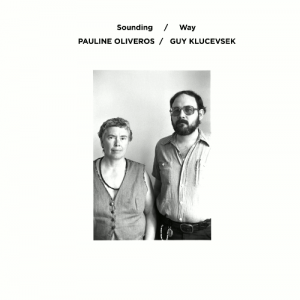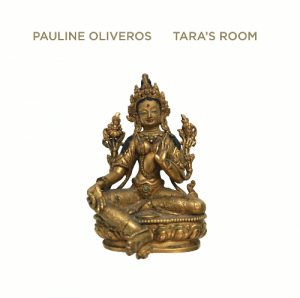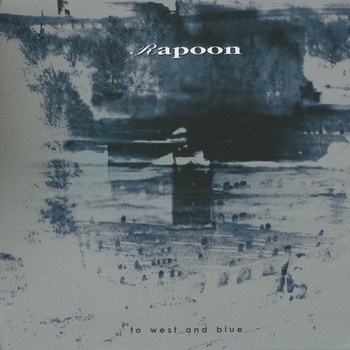 Pauline Oliveros, if you’re not in the know, is somewhat of a hero in twentieth century composition and music theory. She’s also criminally under-recorded. She’s also, perhaps most frustrating of all, very difficult to pin down on a recording. Discogs currently lists sixty-five releases, but few of those are anything like broadly available, and of what I’ve heard of the available / semi-available ones, there’s a number that are extracts of broader pieces.
Pauline Oliveros, if you’re not in the know, is somewhat of a hero in twentieth century composition and music theory. She’s also criminally under-recorded. She’s also, perhaps most frustrating of all, very difficult to pin down on a recording. Discogs currently lists sixty-five releases, but few of those are anything like broadly available, and of what I’ve heard of the available / semi-available ones, there’s a number that are extracts of broader pieces.
Like La Monte Young and Morton Feldman, Oliveros’s time tends towards long, her pieces towards meditation (more on that in a moment). Unlike Young and Feldman, she’s also very quietist — I don’t know if Oliveros the person was impeccably modest, but the Oliveros the composer certainly is.
I suspect that, like Alvin Lucier (though she’s a great deal more sumptuous), part of the problem with having a recorded body of work is that a lot of it is related to space, physical and mental. Much of what I’ve experienced of Oliveros’s ouevre has left me wanting to see it live, to experience it in its proper context. She has this idea of deep listening which is related to a lot of her teaching, and her work tends to benefit from heightened attenuation (which may not be the same as heightened concentration). Another composer who’s possibly in that cache is Charlemagne Palestine. Have seen him quite a few times and always works so much better in the live setting, with the seats and the lights and the dramaturgy. Similarly with these pieces — I want to listen to them in the middle of the night, just on the cusp of sleep, when consciousness is drifting and the music can better soak into your pores. But to the review proper. Sounding/Way is two duos for two accordionists, Oliveros and Guy Kucevsek, originally released as a cassette in 1986, but unavailable since. Both pieces possibly exhibit why Oliveros was so keen on the instrument — the bellows allow for the kind of shifts in emphasis that follow the long in/out of meditative breathing. Both pieces flutter around a fairly confined melodic area, nominally not far away from minimalism, but in real terms approximating very different sonic results. It’s certainly not as formula-laden as minimalism, and the careful but varied rhythms allow for all sorts of sonorities to appear from the two squeeze boxes.Both pieces have that quality of leaving the room feeling lighter when they depart. As an introduction, they’re definitely strong contenders for giving an idea of what Oliveros was about. Though I would far prefer that they were being played in front of me; my home speakers are OK, but there’s this real sense of getting only a slice of the sort of tonal miasma that would float around these pieces IRL.
Secondly we have Tara’s Room, Oliveros playing solo on a just intonation accordion and from the year after our previous offering. Opener “The Beauty Of Sorrow” is quite an astonishing piece. Actually probably more “traditionally” musical than a lot of her work, it’s a thing of quiet, brooding beauty, with the plaintive accordion accentuated with the Expanded Instrument System — seemingly effects that allow for more supplemental material from a soloist.Perhaps the most astonishing thing is how comfortable her ear is with drifting from melody to timbral effect, from plaintive melody to micro-study on bending intervals. There’s a small number of flourishes, but this isn’t “showy” playing. It’s entirely gorgeous and probably the piece of Oliveros’s I’ve heard that sounds most like it’d appeal outside of avant composer circles.
Following that, the title track is probably more quietist than anything on these two collections — it’s very quiet, and possibly dwelling on the recording space, features loops and various rhythmically inconsistent sounds. It’s probably the piece that’s hardest for me to listen to, because it at once requires quite a bit of concentration, as well as a quiet environment and the right headspace. That’s not to say it’s deficient in any way, but by comparison to “The Beauty Of Sorrow”, this is just that more evasive. I’m sure if I could listen to it in the middle of the night, it’d be perfect — a strangely ungraspable shadow of sonic effect, whispered half-voices and whistles. So despite my reservations around wanting to hear these live — or perhaps that recordings aren’t the perfect medium for Oliveros’s work — these really are a great introduction to her oeuvre. From one perspective they’re the pieces that could impress the sorts who like minimalism; from the academic perspective, they give a clear exposition of how she manifested her musical theories. More broadly, she bangs, and these pieces bang, and you should probably get the bangers in your earholes.-Kev Nickells-




